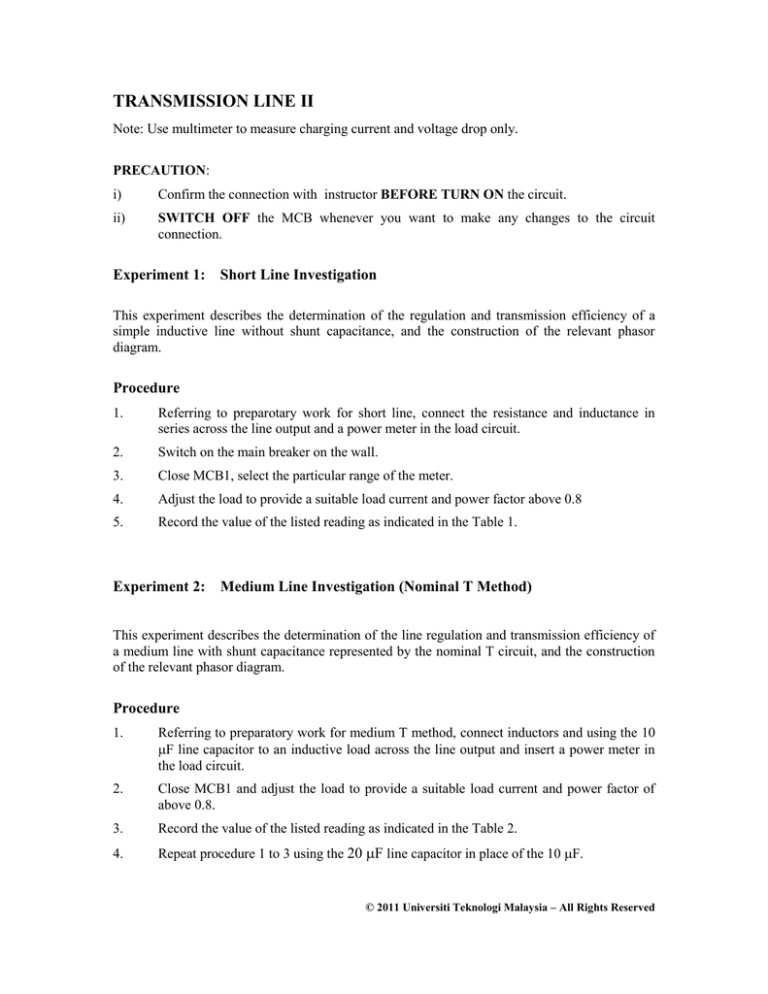
TRANSMISSION LINE II
Note: Use multimeter to measure charging current and voltage drop only.
PRECAUTION:
i)
Confirm the connection with instructor BEFORE TURN ON the circuit.
ii)
SWITCH OFF the MCB whenever you want to make any changes to the circuit
connection.
Experiment 1: Short Line Investigation
This experiment describes the determination of the regulation and transmission efficiency of a
simple inductive line without shunt capacitance, and the construction of the relevant phasor
diagram.
Procedure
1.
Referring to preparotary work for short line, connect the resistance and inductance in
series across the line output and a power meter in the load circuit.
2.
Switch on the main breaker on the wall.
3.
Close MCB1, select the particular range of the meter.
4.
Adjust the load to provide a suitable load current and power factor above 0.8
5.
Record the value of the listed reading as indicated in the Table 1.
Experiment 2: Medium Line Investigation (Nominal T Method)
This experiment describes the determination of the line regulation and transmission efficiency of
a medium line with shunt capacitance represented by the nominal T circuit, and the construction
of the relevant phasor diagram.
Procedure
1.
Referring to preparatory work for medium T method, connect inductors and using the 10
F line capacitor to an inductive load across the line output and insert a power meter in
the load circuit.
2.
Close MCB1 and adjust the load to provide a suitable load current and power factor of
above 0.8.
3.
Record the value of the listed reading as indicated in the Table 2.
4.
Repeat procedure 1 to 3 using the 20 F line capacitor in place of the 10 F.
© 2011 Universiti Teknologi Malaysia – All Rights Reserved
Experiment 3: Medium Line Investigation (Nominal Method)
This experiment describes the determination of the regulation and transmission efficiency of a
medium line with shunt capacitance, represented by the nominal circuit, and the construction of
the relevant phasor diagram.
Procedure
1.
Referring to preparatory work for medium- method, using 5 F line capacitors,
connect an inductive load across the line output and insert a power meter in the load
circuit.
2.
Close MCB1 and adjust the load to provide a suitable load current and power factor of
above 0.8.
3.
Record the value of the listed reading as indicated in the table 3.
4.
Repeat procedure 1 to 3 with two 10 F line capacitor.
Table 1: Short line investigation
Value
Required Reading
(p.f. > 0.8)
Value
Power Meter
Sending end voltage, VS (V)
Cos (p.f.)
Receiving end voltage, VR (V)
VOLT
Sending end current, IS (A)
AMP
Receiving end current, IR (A)
Watt
(p.f. > 0.8)
Voltage drop, Vd
a)
Calculate the receiving end power factor by taking readings from the wattmeter
and receiving end voltage and current
b)
Construct the phasor diagram as described in Fig. 1 (theory) and determine the line
regulation and transmission efficiency.
© 2011 Universiti Teknologi Malaysia – All Rights Reserved
Table 2: Medium line investigation (nominal T)
Required Reading
Value (C = 10F)
Value (C = 20F)
(p.f. > 0.8)
(p.f . > 0.8)
Value (C = 10F)
(p.f. > 0.8)
Value (C = 20F)
(p.f. > 0.8)
Receiving end voltage drop, Vd1 (V)
Sending end voltage drop, Vd2, (V)
Sending end current, IS (A)
Receiving end current, IR (A)
Capacitor current, IC (A)
Sending end voltage, VS (V)
Receiving end voltage, VR (V)
Capacitor voltage, VC (V)
Power Meter
Cos (p.f.)
VOLT
AMP
Watt
a)
Construct the phasor diagram as described previously on page 2 and 3 (Figure 4 - theory)
and determine the line regulation and transmission efficiency.
b)
Determine the effective values of line resistance and inductive reactance for the particular
value of load current, carry out calculations to verify the results obtained.
© 2011 Universiti Teknologi Malaysia – All Rights Reserved
Table 3 : Medium line investigation (nominal )
Required Reading
Value(C = 5F)
Value(C = 10F)
(p.f above 0.8)
(p.f above 0.8)
Value (C = 5F)
Value (C = 10F)
(p.f above 0.8)
(p.f above 0.8)
Sending end voltage, VS (V)
Receiving end voltage, VR (V)
Line inductor voltage drop, Vd1
Sending end current, IS (A)
Receiving end current, IR (A)
Sending end capacitor current, IC1 (A)
Receiving end capacitor current, IC2 (A)
Line current, IL (A)
Power Meter
Cos (p.f.)
VOLT
AMP
Watt
a)
Construct the phasor diagram as described previously on page 4 (Figure 6 - theory) and
determine the line regulation and transmission efficiency.
b)
Determine the effective values of line resistance and inductive reactance for the particular
value of load current, carry out calculations to verify the results obtained.
© 2011 Universiti Teknologi Malaysia – All Rights Reserved
